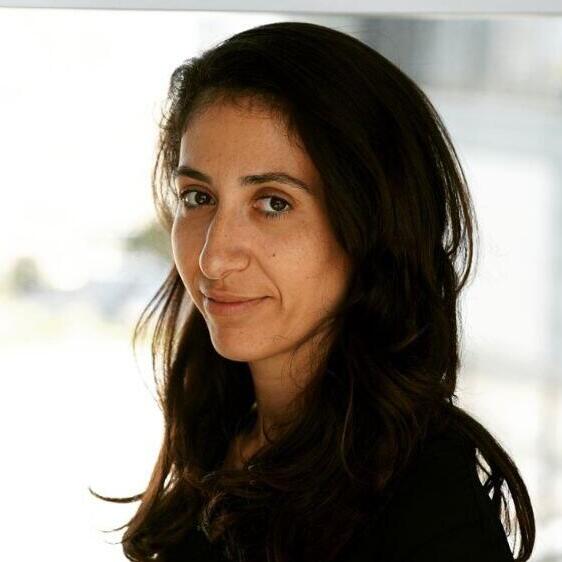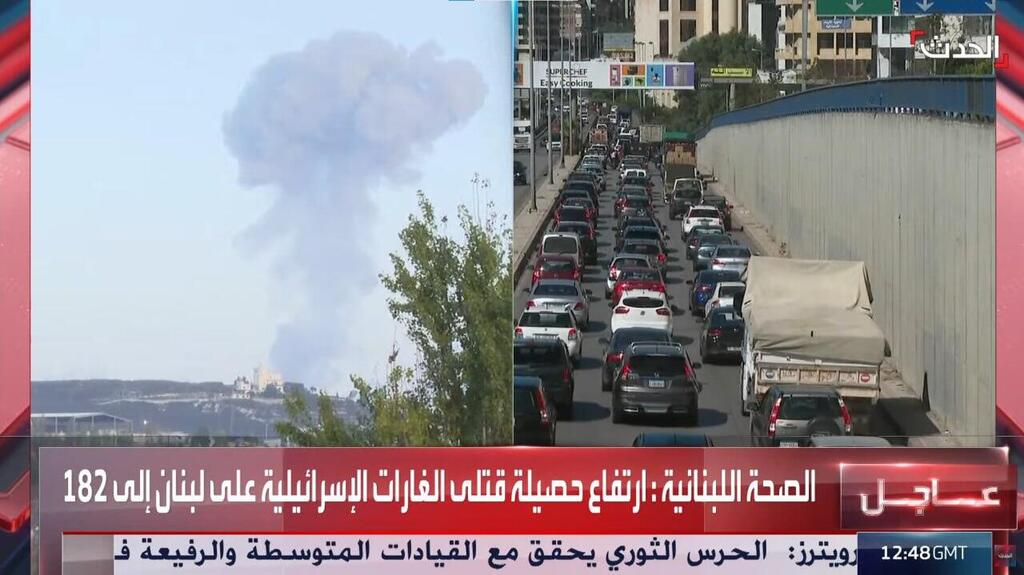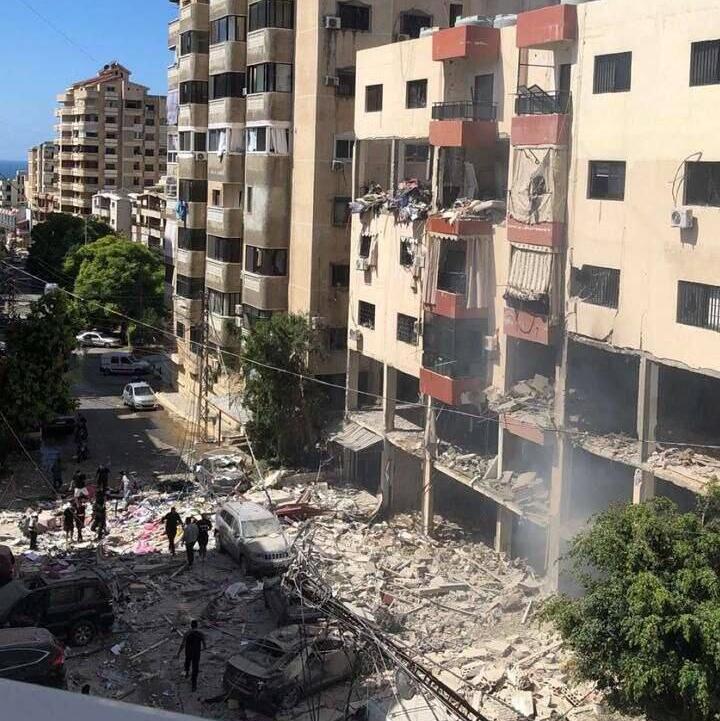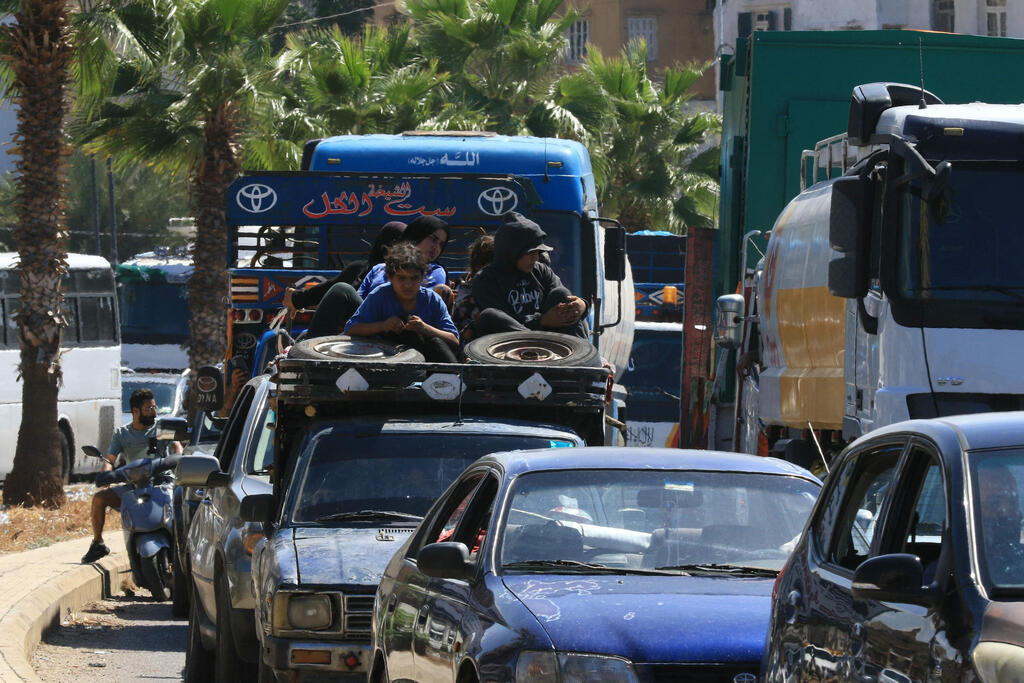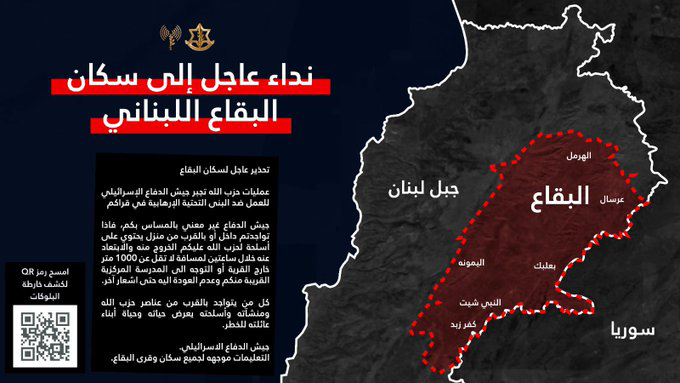Getting your Trinity Audio player ready...
Masses leaving Sidon, southern Lebanon amid Israeli air campaign
Thousands of residents in southern Lebanon were seen fleeing their villages and towns toward Beirut and northern regions on Monday, as the IDF launched extensive airstrikes across the country.
The mass evacuation followed an unusual warning from IDF Spokesperson Rear Admiral Daniel Hagari, who revealed that Hezbollah operatives had planned to launch a cruise missile from a civilian home in southern Lebanon and urged residents to distance themselves from Hezbollah weaponry.
6 View gallery


Masses leaving Sidon, southern Lebanon amid Israeli air campaign
(Photo: AP Photo/Mohammed Zaatar)
Hagari’s warning, widely covered by Arab media, stated that Israeli strikes would continue, advising residents to leave areas near Hezbollah assets. “Hezbollah is endangering you,” Hagari said. The Saudi newspaper Asharq Al-Awsat headlined, “The Israeli military urges Lebanese residents to avoid Hezbollah positions,” while social media was flooded with images and videos of the exodus from southern Lebanon.
A split-screen broadcast by Saudi Arabia’s Al Hadath TV showed heavy traffic at the southern entrance to Beirut on one side and footage of the intense Israeli airstrikes on the other.
Lebanese Education Minister Abbas Al-Halabi announced that schools in Beirut, Tripoli and other cities would open as shelters for those displaced from the south. “The displacement to Mount Lebanon and Beirut has forced us to open schools as shelters,” Al-Halabi told Qatar’s Al Araby TV.
According to AFP, hundreds of families have fled southern Lebanon following the airstrikes. The dramatic move comes after Lebanese Health Minister Firas Al-Abiad said on Saturday that preparations were underway to accommodate displaced persons should the conflict escalate.
Although the images of evacuation were particularly striking on Monday, residents had already been gradually leaving southern border villages since the start of hostilities.
According to Arab reports, in November 2023, the number of displaced people stood at 29,000, rising to 110,000 by August. The Saudi network Al Arabiya recently reported that “Southern Lebanese villages are empty—113,000 displaced cannot return,” citing a United Nations report stating the number of displaced as of September 6.
The report also noted that nearly a year after the conflict began, residents are unlikely to return anytime soon, and the number of displaced continues to grow each month. Visits to southern Lebanese border villages, even briefly, now require coordination with the Lebanese army, the Red Cross and UNIFIL forces.
In recent weeks, Lebanese media have shown images of residents systematically evacuating belongings from villages like Odaisseh and Meiss El Jabal in southern Lebanon.
Ibrahim, a resident of the town of Kfarkela near the Israeli border, told Al Arabiya last week, “The town is almost empty due to the ongoing fighting. Some residents return only to check on their properties or take a few items, at pre-arranged times and under the escort of the Lebanese army and UNIFIL.”
Ibrahim, who has refused to leave Kfarkela, said that over 500 of the town’s 1,500 homes have been destroyed in the strikes.
Another resident, from the village of Khiam, who wished to remain anonymous, said, “The village is deserted. The destruction is extensive, and it’s impossible to return until the war is completely over.”
Reports from early 2024 indicated that most displaced persons were from the areas of Bint Jbeil, Marjayoun and Tyre in southern Lebanon and had sought refuge in other parts of Tyre, Nabatieh, Sidon, Baabda, Beirut and other locations. The number of displaced has increased since then, with more villages joining the list.
Following Monday's airstrikes and images of the highways, it seems that even those who had insisted on staying in southern Lebanon over the past few months are now changing their minds.
For many, fleeing northward to Beirut and Dahieh is no longer considered safe either, after an Israeli airstrike on Friday killed senior Hezbollah commander Ibrahim Aqil and other leaders of the terrorist group's elite top Radwan Force.
The Hezbollah-affiliated Lebanese newspaper Al Akhbar reported that on Saturday, residents of Dahieh fled with their children to Mount Lebanon, many without a place to stay. Some slept in their cars, while others searched for apartments late into the night.
Mount Lebanon cities have begun receiving a new wave of displaced people from the south and Dahieh. Unlike the high rents that followed the assassination of Fuad Shukr, prices are now more reasonable. Some Palestinian-Syrian families have opted to temporarily relocate to Syria to escape the possibility of an expanding war.
Prime Minister Benjamin Netanyahu in warning to Lebanese civilians
(Video: GPO)
By midday Monday, the IDF reported having struck over 300 targets across Lebanon and is preparing for continued large-scale operations.
The Lebanese Health Ministry reported at least 182 dead and 727 wounded nationwide, later revising the numbers up to 274 fatalities and 1,024 injuries.
At around 3 p.m., the IDF issued another targeted warning to residents of the Bekaa Valley, urging them to evacuate. In a statement by IDF Arabic Spokesperson Lt. Col. Avichay Adraee, accompanied by a map indicating the area to be evacuated, he called on residents to leave their homes “urgently” within two hours.
“IDF actions are targeting Hezbollah’s terrorist infrastructure in your villages,” the statement read. “The IDF does not want to harm you—if you are in or near a building containing Hezbollah weapons, you must leave and move at least 1,000 meters outside the village or go to the nearest central school and not return until further notice.”
The statement concluded: “Anyone who remains near Hezbollah members, their facilities, and weapons is endangering their own lives and those of their families.”



